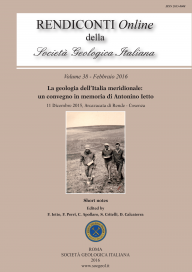
Transition from strike-slip to extensional tectonics in the Plio-Pleistocene Catanzaro Trough (Calabria, south Italy)
Fabrizio Brutto (a), Francesco Muto (a), Maria Filomena Loreto (b), Vincenzo Tripodi (a) & Salvatore Critelli (a)
(a) Department of Biology, Ecology and Earth Science (DiBEST)- University of Calabria, Arcavacata di Rende (CS), Italy. Corresponding author e-mail: fabrizio.brutto@gmail.com
(b) Institute of Marine Sciences – Research National Council, U. O. S. Bologna, Italy.
Volume: 38/2016
Pages: 9-12
Abstract
The Catanzaro Trough (South Italy) is a Neogene-Quaternary sedimentary basin developed between the Serre and the Sila Massif, located in the central Calabrian Arc. Since Miocene, the study area experienced different tectonic phases, resulting confined by both longitudinal and transversal faults systems.
Combining of land geo-structural with marine geophysical data was performed a detailed analysis of processes that during last 5 My have controlled the evolution of western portion of the Catanzaro Trough.
Sedimentary basin hosted by the Catanzaro Trough is controlled, mainly, by NW–SE and NE–SW oriented fault systems. The data analysis allowed us to state the activity of NW-SE oriented faults with strike slip and oblique kinematics related to the opening of a WNW–ESE-oriented paleo-strait connecting the Tyrrhenian area to the Ionian Sea. The NW-SE trending faults have acted since Miocene as edges of a transfer zone, and represent elements of tectonic accommodation between northern and southern Calabrian Arc.
The structural framework is further complicated by the activation of the NE-SW striking normal faults, arranged as a graben-type system, which since Middle Pleistocene segment the western Catanzaro Trough.
Thanks to this multidisciplinary approach we are able to provide a more reliable and detailed structural frame of the central Calabria segment, providing new elements about recent activity of faults, and giving a further contribution for the seismogenetic potential assessment of an area historically considered with the highest earthquake and tsunami risk throughout Italy.
Keywords
Get Full Text